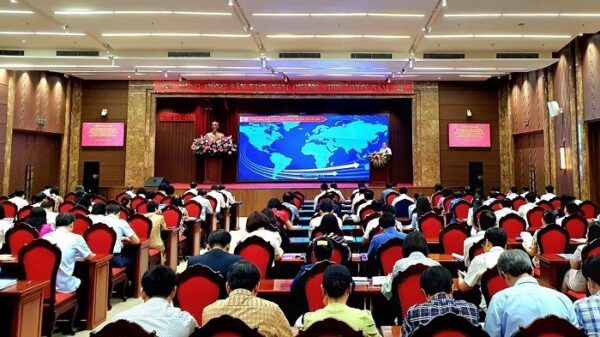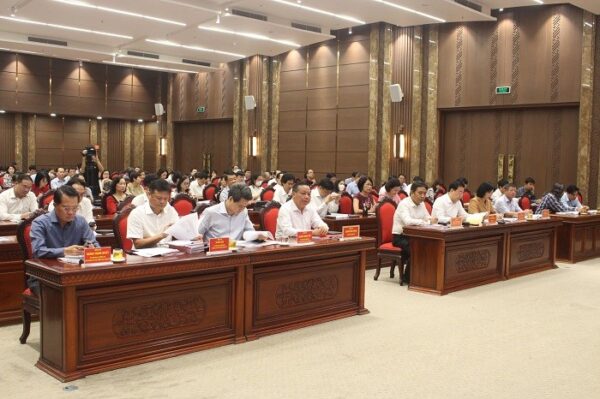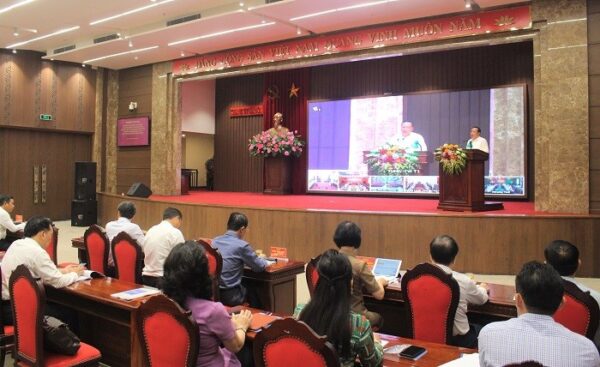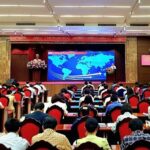
Conference overview
Attending the conference were members of the Standing Committee of the City Party Committee: Head of the Organization Committee of the City Party Committee Vu Duc Bao; Chairman of the Inspection Committee of the City Party Committee Hoang Trong Quyet; Head of the Internal Affairs Committee of the City Party Committee Nguyen Quang Duc…The conference was held in the form of offline combined with online to 625 bridge points in the capital with the participation of 26,374 delegates.
At the conference, Deputy Secretary of the City Party Committee Nguyen Van Phong directly grasped the basic contents of Resolution No. 09-NQ/TU, dated February 22, 2022 of the Standing Board of the Hanoi Party Committee on “Developing cultural industry in the capital in the period of 2021-2025, orientation to 2030, vision to 2045”.
Accordingly, the Resolution aims to create a step for the comprehensive development of the capital’s cultural industries to develop sustainably and become a spearhead economic sector; services, cultural products are diversified, and branded, promoting tourism development and export.

Delegates attending the conference
The goal is to comprehensively develop the Capital’s cultural industries in terms of scale, quality of products, services, and markets, ensuring sustainable development, and becoming a spearhead economic sector with high speed, density, and added value; professional operation, with synchronous and modern infrastructure; diverse, quality, branded services and cultural products that meet the creative and enjoyment needs of the domestic people, and promote tourism development.
The city focuses on investing in developing a number of potential and advantageous fields of the capital such as: Cultural tourism; Performing Arts; Crafts; Design; Advertisement; Fine arts, photography and exhibitions; Film; Fashion; Culinary; Software and entertainment games; Television and Radio; Publishing…aligned with the Capital’s practice and each specific period.
By 2025, the cultural industry of the capital will become an important economic sector, creating a new driving force to promote economic, cultural and social development; complete the review and integration of the cultural industry development planning into the Hanoi master plan to 2030, vision to 2050; improve relatively synchronous and modern infrastructure, prioritize the allocation of the land fund according to the subdivision planning on the 2 banks of the Red River to develop cultural industries associated with tourism development.
In addition, the city will perfect mechanisms, policies , statistical indicator systems, deploy digitalization, connect and share digital data to ensure the development of a connected and professional cultural industry; invest, develop high quality, diversified, unique, branded cultural products and services, which imbued with Hanoi’s cultural identity; invest and embellish the system of cultural institutions, national monuments, and World Heritage Sites of the Imperial Citadel of Thang Long..; maintain and develop the brand of the capital of thousand years of civilization, “City for peace”, “Creative city”. The cultural industry strives to contribute about 5% of the City’s GRDP.

Deputy Secretary of the City Party Committee Nguyen Van Phong thoroughly grasped at the conference
By 2030, the capital’s cultural industry will basically become a spearhead economic sector, strongly promoting the development of other industries and fields. Hanoi is in the group of cities with the leading developed cultural industry with prestigious brands and products, and high competitiveness with other cities in the region; is an influential “Creative City” in Southeast Asia. Revenue from cultural industries is expected to increase year by year, contributing about 8% of the City’s GRDP.
By 2045, the capital’s cultural industry is a spearhead economic sector, comprehensively developed, and a driving force for the development of other industries and fields, a premise for building a high-quality living in Hanoi; comprehensive and sustainable economic, cultural and social development; becoming the “Creative City” of Asia, a globally connected city, a large unique cultural and tourist center, with international competitiveness.A number of new cultural works for the Capital and Vietnam, with cultural symbols of regional and world stature will be formed. It is expected to contribute about 10% of the City’s GRDP.
To achieve the above goal, Hanoi must renew its thinking and awareness. Cultural industry development is a regular, continuous, and long-term process that must be constantly supplemented and perfected. The cultural industry is a new economic sector that requires specific methods and strategies to break through, satisfying the requirements of turning the cultural industry into the City’s spearhead economic sector.
Accordingly, the city should focus on building and promulgating mechanisms and policies to promote creativity and cultural industry development; perfecting the structure of the cultural industry, ensuring synchronous development in the overall socio-economic development of the capital.
Review and update “Hanoi Cultural Development Planning” into the adjustment of the City Plan; propose new investment solutions to improve relatively synchronous and modern infrastructure, in which priority is given to the allocationof land fund according to the planning of subdivision 2 on the banks of the Red River and urban development areas, satellite towns to build cultural and tourist works…; at the same time, supplementing the Hanoi cultural development planning to each locality to ensure consistency in the views and goals for the development of the cultural industry in the capital and the whole country with a vision to 2045.
Furthermore, develop mechanisms and policies specific to the Capital to promote creativity based on industrial and cultural resources for long-term development, such as: transforming industrial heritage, old houses and villas, urban heritage, memory heritage, and memory heritage into new cultural heritage; developing traditional handicrafts and products… There are policies and mechanisms in place to stimulate and promote investment in the development of various forms of cultural industries. Focus on mechanisms to ensure the effectiveness of intellectual property rights enforcement and exploitation in compliance with the law.
Hanoi also focuses on developing the cultural industry market in potential and advantageous areas such as urban areas, traditional craft villages, through training programs, or linking with international experts to improve the creative capacity, towards the international market.
Select to build high-quality product and service brands to promote Hanoi’s cultural industry to the whole country and the world in combination with tourism and activities to attract domestic and foreign investment.
To attract and support investment, the City aims to plan and arrange land funds and investment resources of the state and non-state for high-quality cultural development works and projects, in which: Prioritize the development of public space, cultural tourist attractions, entertainment, performing arts, street-walking space, shopping spots, expand to create cultural space for the community.
Drastically implement a number of projects and planning schemes to preserve and promote the value of world heritages, special national monuments and national monuments, concurrently develop a number of new cultural works, forming new cultural symbols for the Capital and has the potential to develop cultural industries associated with tourism.
Implement preferential policies, promote investment promotion and development of cultural industries that have advantages and potentials such as performing arts, handicrafts, design, software and games. entertainment, cultural tourism, food, etc. Develop a network of cultural enterprises, in which a number of large corporations in the cultural industry are formed.
Trọng Toàn

